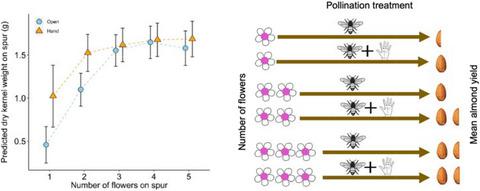当前位置:
X-MOL 学术
›
Plant Biol.
›
论文详情
Our official English website, www.x-mol.net, welcomes your
feedback! (Note: you will need to create a separate account there.)
Pollination and resource limitation as interacting constraints on almond fruit set.
Plant Biology ( IF 4.2 ) Pub Date : 2019-10-13 , DOI: 10.1111/plb.13045 S A Cunningham 1 , M J Evans 1 , M Neave 2 , J Armstrong 2 , P S Barton 1
Plant Biology ( IF 4.2 ) Pub Date : 2019-10-13 , DOI: 10.1111/plb.13045 S A Cunningham 1 , M J Evans 1 , M Neave 2 , J Armstrong 2 , P S Barton 1
Affiliation

|
Pollination and resource availability are factors determining reproductive success of plants, and in agriculture these factors influence yield of fruit-bearing crops. Our understanding of the importance of crop pollination is fast improving, but less is known about how the interaction between pollination and resources constrains fruit production. We conducted an experiment with almond trees (Prunus dulcis) to examine how the number of flowers, light availability and competition for resources affected nut (fruit) production on individual spurs (fruit-bearing structures) exposed to open-pollination or hand-pollination. We found a positive relationship between flower number and nut number on spurs with up to four flowers, but no further benefit after four flowers, suggesting a resource threshold expressed by individual spurs. Spurs with few flowers increased the conversion rate of flowers to nuts when supplemented with hand-pollination, but spurs with more flowers were more likely to achieve the threshold number of nuts even under open-pollination. Our experiment included a further treatment involving spraying whole trees with pollen. This treatment reduced nut production by spurs with many flowers and high light availability, suggesting competition is experienced by well-resourced spurs when resources need to be shared among developing nuts across the whole tree. Our study supports the hypothesis that excess flower production in fruit trees increases the potential for fruit production when pollinator and resource availability is variable (bet-hedging). Spurs with more flowers typically produce more nuts (within a limited range), but only if both resources and pollen supply increase with flower number. For almond growers, a focus on maintaining high flower numbers, especially in high light regions of the canopy, is the foundation for high levels of production. Strategies to lift flower number and light are complicated by trade-offs inherent in tree architecture and orchard design. However, fruit set would be lifted above that achieved by current practice by an increase in the pollination rate of flowers.
中文翻译:

授粉和资源限制是对杏仁果实的相互作用的限制。
授粉和资源可利用性是决定植物繁殖成功的因素,而在农业中,这些因素会影响水果作物的产量。我们对农作物授粉重要性的理解正在迅速提高,但是对于授粉与资源之间的相互作用如何限制果实生产的了解还很少。我们对杏仁树(Prunus dulcis)进行了一项实验,以研究花朵的数量,光的可获得性和资源的竞争如何影响暴露于开放授粉或手工授粉的单个马刺(果实结构)上坚果(果实)的产量。我们发现最多有四朵花的马刺上的花数与坚果数之间呈正相关,但四朵花后没有进一步的好处,这表明由单个马刺表达的资源阈值。花少的马刺在人工授粉的情况下增加了花到坚果的转化率,但是花多的马刺即使在开放授粉的情况下也更有可能达到坚果的阈值数量。我们的实验包括进一步的处理,包括用花粉喷洒整棵树。这种处理减少了具有许多花和高光利用率的马刺的坚果生产,这表明当需要在整棵树上的坚果之间共享资源时,资源丰富的马刺会经历竞争。我们的研究支持以下假设:当传粉媒介和资源可利用性发生变化(对冲)时,果树上的过量花卉生产会增加水果生产的潜力。花多的马刺通常会产生更多的坚果(在有限的范围内),但前提是资源和花粉供应都随着花数的增加而增加。对于杏仁种植者,尤其是在冠层的高光区域,重点在于保持高花数是高产量的基础。树木结构和果园设计所固有的权衡取舍,使得提高花朵数量和光照的策略变得复杂。然而,通过增加花的授粉率,坐果将被提高到目前的做法之上。
更新日期:2019-10-13
中文翻译:

授粉和资源限制是对杏仁果实的相互作用的限制。
授粉和资源可利用性是决定植物繁殖成功的因素,而在农业中,这些因素会影响水果作物的产量。我们对农作物授粉重要性的理解正在迅速提高,但是对于授粉与资源之间的相互作用如何限制果实生产的了解还很少。我们对杏仁树(Prunus dulcis)进行了一项实验,以研究花朵的数量,光的可获得性和资源的竞争如何影响暴露于开放授粉或手工授粉的单个马刺(果实结构)上坚果(果实)的产量。我们发现最多有四朵花的马刺上的花数与坚果数之间呈正相关,但四朵花后没有进一步的好处,这表明由单个马刺表达的资源阈值。花少的马刺在人工授粉的情况下增加了花到坚果的转化率,但是花多的马刺即使在开放授粉的情况下也更有可能达到坚果的阈值数量。我们的实验包括进一步的处理,包括用花粉喷洒整棵树。这种处理减少了具有许多花和高光利用率的马刺的坚果生产,这表明当需要在整棵树上的坚果之间共享资源时,资源丰富的马刺会经历竞争。我们的研究支持以下假设:当传粉媒介和资源可利用性发生变化(对冲)时,果树上的过量花卉生产会增加水果生产的潜力。花多的马刺通常会产生更多的坚果(在有限的范围内),但前提是资源和花粉供应都随着花数的增加而增加。对于杏仁种植者,尤其是在冠层的高光区域,重点在于保持高花数是高产量的基础。树木结构和果园设计所固有的权衡取舍,使得提高花朵数量和光照的策略变得复杂。然而,通过增加花的授粉率,坐果将被提高到目前的做法之上。











































 京公网安备 11010802027423号
京公网安备 11010802027423号